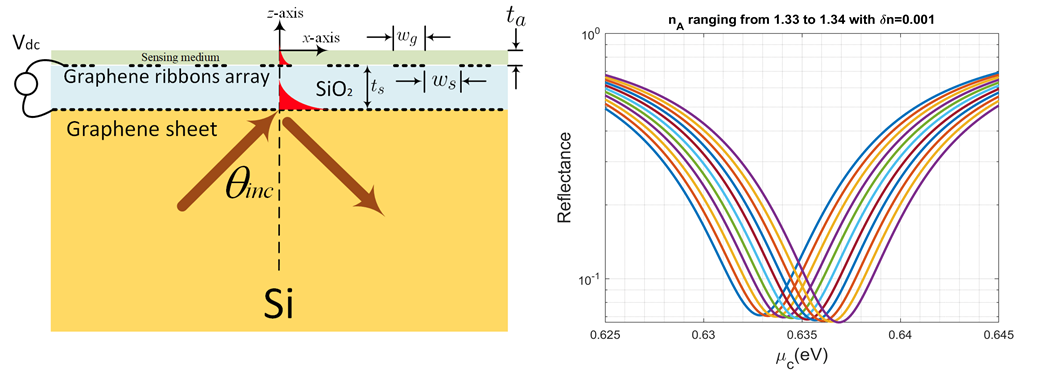A theoretical design of evanescent wave biosensors based on gate-controlled graphene surface plasmon resonance
相位陣列技術實驗室
黃瑞彬教授
相位陣列技術實驗室
黃瑞彬教授

This research presents the theoretical design and electro-magnetic full-wave numerical verification of a surface plasmon resonance (SPR) sensor based on a gate-controlled periodic array of graphene ribbons.
Unlike traditional methods that monitor reflectivity variations with respect to incident angle or wavelength, this approach measures the change in the surface plasmon resonance (SPR) curve at a fixed incident angle and wavelength against the variation of graphene chemical potential (achieved by dynamically tuning the gate voltage), eliminating the need for rotating mirrors, tunable filters, or spectrometers for angular or wavelength interrogation.
It is interesting to observe that this non-metallic biosensor can detect the redistribution (lateral shift) of analytes modeled as a periodic array of discrete sensing media, such as live viruses.
Theoretical calculations show that the sensitivities for analyte refractive index (RI) equal to 1.33, 1.34, 1.35, and 1.36 are 36,401.1 mV/RIU, 40,676.5 mV/RIU, 40,918.2 mV/ RIU, and 41,160 mV/RIU, respectively, with corresponding figures of merit (1/RIU) of 21.84, 24, 23.74, and 23.69.
The left figure illustrates the 2D structure of the biosensor for electromagnetic full-wave simulation. The simulation involves a TM-polarized plane wave that is obliquely incident from a dense medium (i.e., the substrate) to a less dense medium (the slice) to generate an evanescent wave. The sensing medium to be detected is positioned above the graphene ribbon array.
The right figure depicts the plots of the reflectance versus chemical potential. The curves from left to right represent the reflectance of various analyte refractive indices ranging from 1.33 to 1.34 with a step size of ΔnA = 0.001. As shown in this figure, the shift in the SPR curve is clear enough to observe changes in the refractive index.
▶ R.-B. Hwang, “A theoretical design of evanescent wave biosensors based on gate-controlled graphene surface plasmon resonance,” Scientific Reports, volume 11, 2021. (Link)



